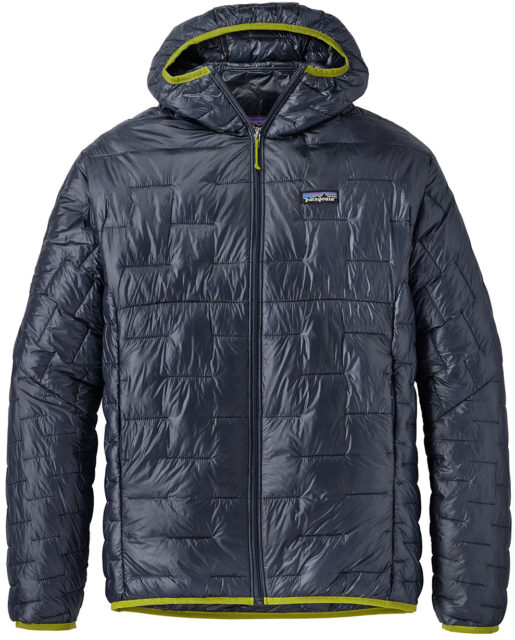
Patagonia Micro Puff Hoody
Stated Features:
- Ultralight nylon ripstop Pertex Quantum® GL shell with a DWR (durable water repellent) finish.
- Sheds precipitation, blocks wind and allows insulation to remain fully lofted and warm.
- 65-g PlumaFill insulation replicates the structure of down in a lofty synthetic with warm-when-wet performance.
- The unique construction of PlumaFill insulation stabilizes the fibers to prevent shifting, clumping and cold spots associated with down or other synthetic down alternatives.
- For next-to-skin comfort at the chin, the center-front zipper has a wicking interior storm flap and a zipper garage.
- Two welted zippered handwarmer pockets; left pocket doubles as a stuffsack with a reinforced carabiner clip-in loop for attaching to a harness or pack.
- Ultralight binding at hem and cuffs seals out drafts and locks in body heat.
MSRP: $299
Size Tested: Medium
Stated Weight: 263 g
Blister’s Measured Weight:
- Luke Koppa’s size Medium: 256 g
- Sam Shaheen’s size Medium: 254 g
Reviewers
- Luke Koppa: 5’8”, 155 lbs
- Sam Shaheen: 5’10”, 135 lbs
Test Locations: Crested Butte, Weninuche Wilderness, Rocky Mountain National Park, Front Range, & Cameron Pass, CO; Eagle River, WI
Days Tested: ~125
Intro
Down vs Synthetic — this has been the debate ever since people started stuffing their jackets and blankets with something other than bird feathers. But last year, Patagonia introduced their Micro Puff Hoody, and this little piece aimed to upend the terms of the entire debate.
Historically, down has reigned supreme for its unmatched warmth-to-weight ratio. But it still falters in wet conditions, where it loses nearly all of its insulative value. Water-resistant treatments have curtailed down’s loss of loft when wet, but synthetic insulations still offer much more reliable warmth when soaked. Down also comes with the ethical and environmental concerns associated with raising and killing (or in some particularly rough cases, live-plucking) geese for their down. So people have had to either use down pieces that were warmer for the weight but were not ideal for wet conditions, or wear heavier synthetic options.
Till now.
Patagonia claims that their Micro Puff Hoody actually has the highest warmth-to-weight ratio out of all their insulation pieces — down or synthetic.
So both Sam Shaheen and I have been testing the Micro Puff Hoody to get an idea of its warmth, offer some comparisons, and see how “revolutionary” this piece actually is.
Fabric, Insulation, and Comparisons
The Micro Puff Hoody utilizes a 10-denier nylon ripstop Pertex Quantum GL fabric for both the face and lining, and Patagonia says that it’s the lightest fabric they’ve ever used. The fabric is definitely designed for absolute minimum weight, and it strays away from the materials used in comfortable, stretchy insulators like the Patagonia Nano-Air Hoody. Compared to those fabrics, the Pertex Quantum GL feels stickier on skin and more crinkly, as most tightly woven, downproof fabrics do.
However, the Micro Puff’s fabric slides easily over and under layers, and feels just fine if it’s not touching sweaty skin. Combined with the airy PlumaFill insulation, the ultralight fabric makes the Micro Puff Hoody feel very much like the Patagonia Ultralight Down Hoody, which uses a similar 10-denier fabric, but utilizes 800-fill-power down rather than a synthetic insulation.
The Micro Puff Hoody’s fabric is also noticeably thinner, lighter, and shinier than the 22-denier polyester face fabric of the Patagonia Nano Puff Jacket.
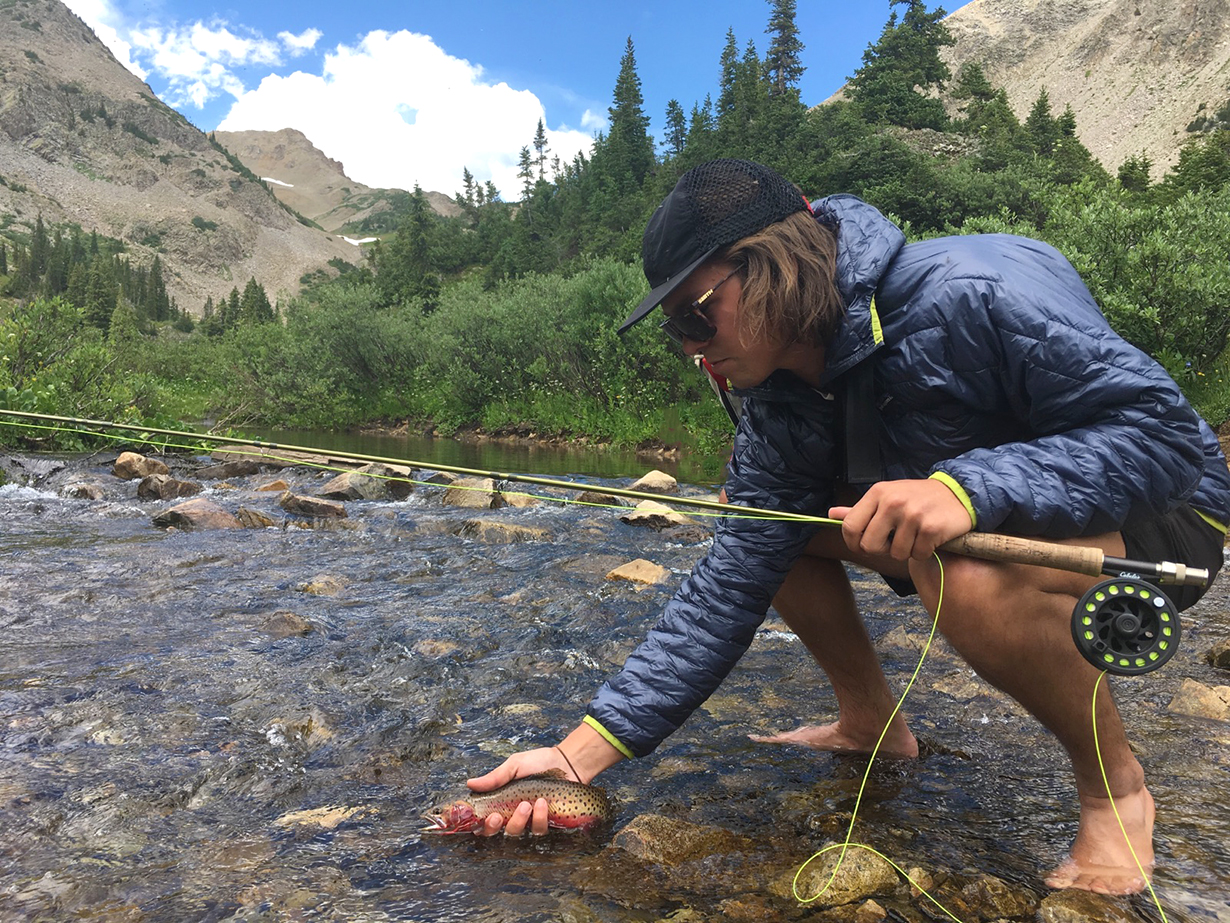
The Micro Puff Hoody’s PlumaFill insulation consists of long, thin, hair-like fibers (thinner than a human hair) that are wrapped around a stabilizing fiber. This results in a very light insulation that lofts very high — Sam has even been losing a few “feathers” like you would with an analogous down garment. However, he was by no means losing a significant amount of insulation, and Patagonia has clarified that this is likely limited to the pre-production samples we tested, and should not happen with production versions.
The patent-pending construction on the Micro Puff Hoody is also unique, and consists of a discontinuous pattern of sewn-through lines where there are no completely separated baffles, but rather a series of offset stitches. This construction implies that the PlumaFill insulation has fewer issues with migration than down and other non-batted synthetic insulations, and Patagonia claims this construction creates fewer cold spots.
This unique construction is also a significant part of the aesthetics of the jacket. It’s minimal, unique, quilting allows for plenty of loft, and is a welcome departure from the huge horizontal channels found on most down pieces.
Fit
The Micro Puff Hoody has a roomier fit than most other technical, alpine-cut pieces that we’ve reviewed (e.g., the Patagonia Nano-Air Light Hoody, Outdoor Research Ascendant Hoody, North Face Radium Jacket, Marmot Alpha Pro, etc.) but it’s a bit slimmer than the Patagonia Nano Puff Jacket and the standard Patagonia Down Sweater.
This moderate fit makes the Micro Puff Hoody a bit more versatile than tighter midlayers in terms of additional layering, and it’s roomy enough to toss over another layer or a slim shell.
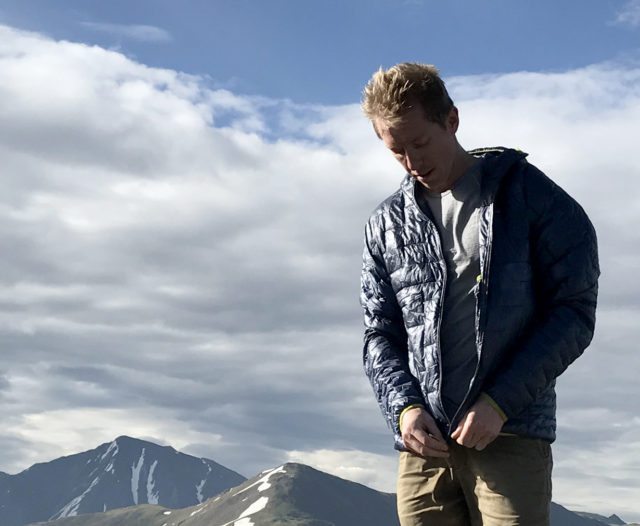
Sam and I both wore the Micro Puff Hoody in a size Medium, and agreed that it has a pretty standard torso and sleeve length. The hood is big enough to squeeze over a climbing helmet, but it won’t fit over a ski helmet (Patagonia advertises the hood for under-the-helmet use).
The Micro Puff Hoody has a bit of extra room just about everywhere. Sam has been wearing it with the Nano-Air Light Hoody underneath, and that combo fits together great. If you’re looking for a streamlined insulator to wear only over a base layer, the Micro Puff Hoody might be a bit roomy, but we don’t think that the fit will be a deal breaker for many people.
Features
The Micro Puff Hoody has two deep, interior drop-in pockets, two zippered handwarmer pockets, and a simple elastic binding on the cuffs, hood, and bottom hem.
One of the handwarmer pockets doubles as a stuff sack, and unlike many stuff pockets, it has plenty of room to pack the jacket within itself easily. This means that the Micro Puff Hoody looks rather large when stuffed into its pocket, but since it is by no means fully compressed, you can cram it into any open space in your pack and it will smash down even further. The final compressed size of the Micro Puff Hoody is less than a liter, and the stuff pocket has a solid webbing loop to clip to a harness or pack.
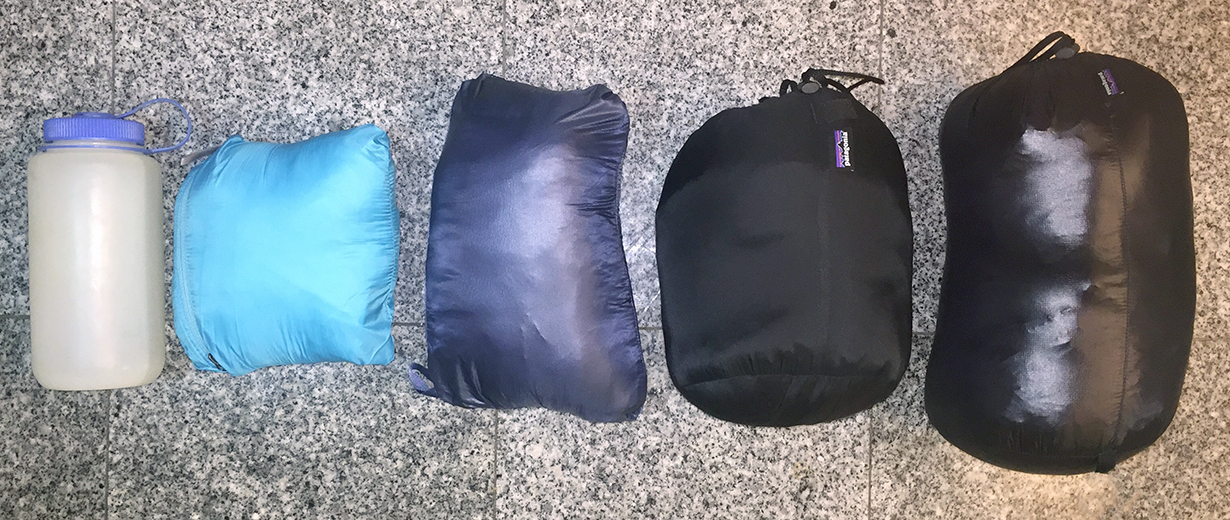
Weight
Since the Micro Puff Hoody is all about maximum warmth for minimum weight, here are a few stated weights of similar jackets for comparison (insulation types in parentheses):
219 g Mountain Hardwear Ghost Whisperer Hooded Jacket (800-fill-power down)
264 g Patagonia Micro Puff Hoody (65 g PlumaFill) (ours weighed in at ~255 g)
298 g Patagonia Ultralight Down Hoody (800-fill-power down)
363 g Patagonia Nano Puff Hoody (60 g Primaloft Gold Eco)
Warmth + Comfort
The Micro Puff Hoody has the best warmth-to-weight ratio of any synthetic midlayer we have ever used, which includes pieces that use insulations such as Primaloft Gold, Coreloft, Polartec Thermal Pro, Polartec Alpha Direct, VerticalX, and Thermoball.
The Micro Puff Hoody is also the closest synthetic we’ve used when it comes to replicating that lofty, down-like feel.
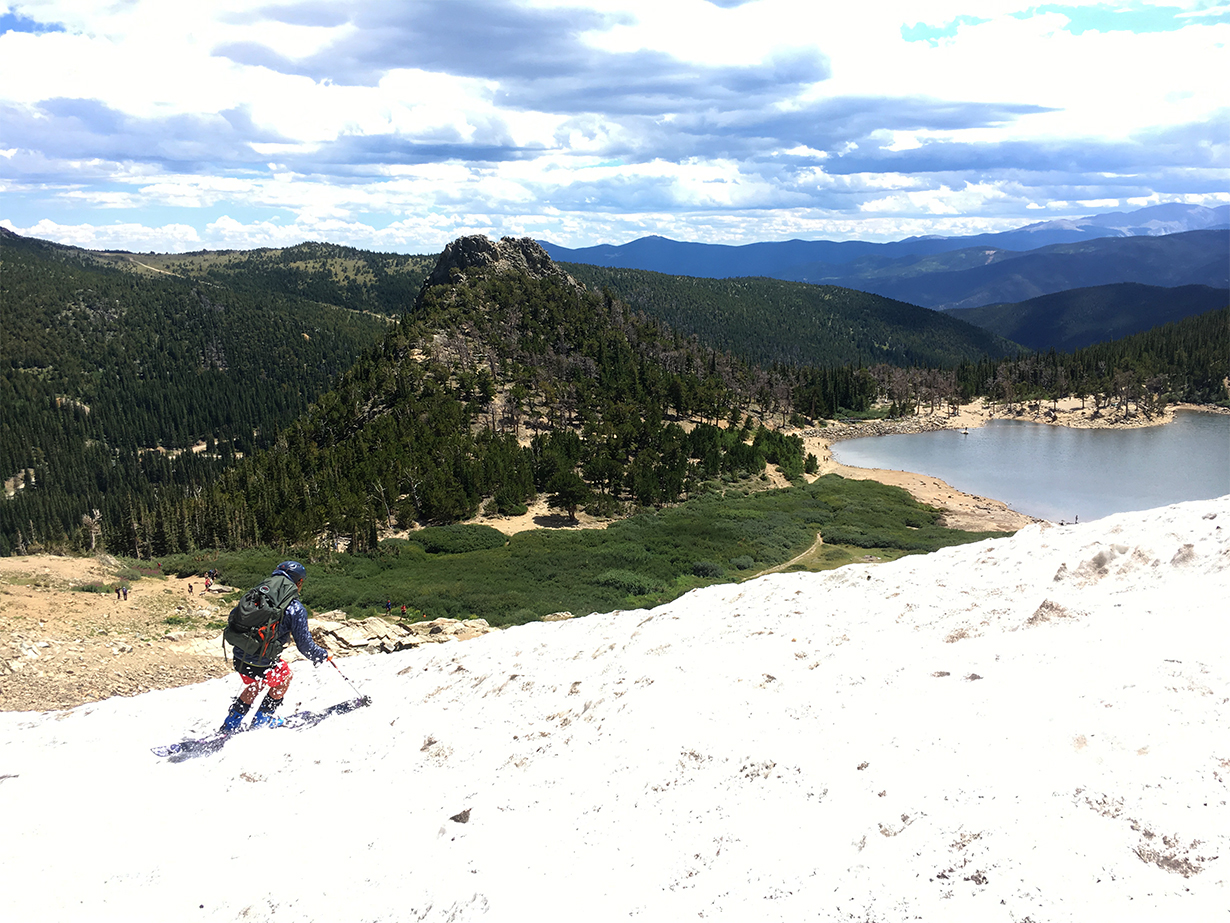
Unfortunately, we’ve so far only tested the Micro Puff Hoody during the summer, so we haven’t had a chance to get it in temperatures below ~40°F, but in these conditions the Micro Puff Hoody has felt significantly warmer than the Patagonia Nano Puff, and we’ll soon be comparing the Micro Puff to some of its down competitors.
The objective warmth of a garment is difficult to gauge, but from our experience so far, the Micro Puff Hoody does indeed seem to be a significant step forward in the realm of synthetic insulation, and we are looking forward to testing it in colder conditions.
[Editor’s Note: Keep reading for our comments on the Micro Puff Hoody’s cold-weather performance.]
Weather Resistance
The Micro Puff Hoody is constructed similarly to most down pieces, with a thin, tightly woven face fabric that’s treated with a DWR finish. Because of this, the Micro Puff Hoody’s weather resistance is fairly predictable — it blocks the majority of wind (though not all of it due to the sewn-through construction), a small amount of light precip (before the DWR wets out on the shell fabric) and a decent amount of snow in the winter.
The shell fabric on the Micro Puff Hoody is very thin, which does present some durability concerns, but it hasn’t seemed to affect the weather resistance of the piece adversely.
Durability
The real test of durability will be over the next several years while we see how quickly the PlumaFill insulation breaks down. One of the primary benefits of down insulation is that it tends to last a bit longer than synthetics since the feathers don’t break down as fast as the more brittle synthetic fibers. Only time will tell, but we’ll be sure to update this review as we get a better feel for PlumaFill’s durability.
The face fabric of the Micro Puff Hoody is also extremely thin, and obviously not meant to deal with a whole lot of abrasion.
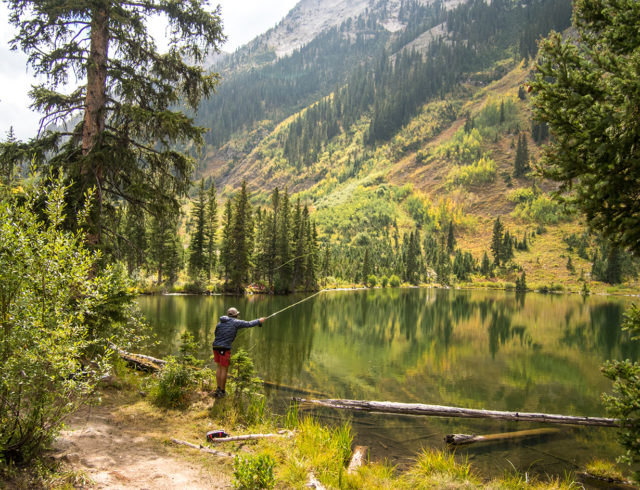
In general, though, after about seven days each in the piece, neither of us have had any durability concerns. The shell fabric on both of our hoodies is in perfect shape after being repeatedly stuffed into and out of full packs, rubbing against trad-racks, backcountry cooking supplies, snacks, etc.
[Editor’s Note: We now have ~125 days in the Micro Puff Hoody, and you can check out our updated durability section on the next page.]
Bottom Line (For Now)
So far, the Patagonia Micro Puff Hoody has proven to be a very efficient insulator, more so than any other synthetic midlayer we’ve used. Its minimal features serve their purposes, and the fit makes it an option for use both underneath or outside of a shell.
We need to spend more time in the Micro Puff Hoody to get a better sense of its durability and performance in colder conditions, but so far, it looks like it could be the best option out there if you’re looking for an ultralight midlayer that will stay warm even when things get wet.
NEXT: Long-Term Update on Durability & Cold-Weather Performance

Live plucking is very uncool, but aren’t most ducks and geese farmed for meat, with down the by product? I don’t see down as a non green friendly material. What are synthetics made of?
Anyway, the jacket looks sweet.
Hey Frame,
There are a few rather unethical processes that plague the down industry. Live plucking and force feeding (for foie gras) are the primary things that accountable supply chains are trying to eliminate. In both cases, the animals are eventually killed for their meat/organs. Some prominent outdoor companies are making huge efforts to eliminate animal cruelty from their supply chains (TNF and Patagonia are the most prominent) but much of the commercial down in the world comes from non-regulated farms and greater supply chains.
As a result, it is difficult to ascertain the extent of force feeding and live plucking at farms where down is harvested but there is no doubt that it does exist. 80% of the world’s down currently comes from China where animal regulations are often quite lax compared to the US and Western Europe.
The outdoor industry has been making steps towards accountable supply chains in the past few years, which is helping with the ethical concerns but it doesn’t change the fact that animals must be killed to harvest their down — a serious ethical concern no matter how humanely we treat them while living. There are also environmental concerns with raising animals for food (and down by proxy) — pressures on water, and other natural resources make farming animals a burden on the environment.
As far as synthetics, there is some environmental concern with manufacturing. The processes can be energy intensive and the materials can be dangerous environmentally or to those working in the factories. However, most companies keep the specifics of process and materials as trade secrets.
It is definitely not a simple black and white issue, but I think on the whole, synthetics come out on top both ethically and environmentally.
Best,
Sam
Thanks Sam
Please read http://www.trailspace.com/articles/sleeping-bag-construction-baffles-shingles.html to learn what baffles are (ie, the material between the inner and outer shell). I think every time you write “baffle” you mean “chamber.” This jacket appears to use sewn-through quilting, not baffles.
Hi Tom,
That is correct – the Micro Puff Hoody does not utilize a fully-baffled construction – the separations are sewn through like most similar insulated mid layers, and does not feature the separate fabric baffles you often see in sleeping bags and warmer down parkas.
But we chose to use the term “baffles” rather than “chambers” since companies have been using the term “baffles” to describe both actually baffling and sewn-through quilting for years, to the point that the terms now are very often (mistakenly) used interchangeably. As a result, many people will better understand what we’re describing if we used the term baffles. So it’s the result of widespread misuse of the term — and why most companies now use “box baffles” or “fully-baffled” when describing their garments that feature true baffled construction.
Cheers,
Luke
Hi Sam and Luke,
I have been debating if I want to purchase this jacket or not…we are headed to Italy next week, where it is showing the high of mid 60’s and lows mid 40’s…I know it has not been cold enough for y’all to truly try out the jacket – but do you know what temps they recommend the jacket for? I am from the South, so we are not used to cooler weather. I would love for this to work due to how compact it is for traveling. Would love any feedback. Thank you
Hi Leslie,
Thanks for reaching out. As always, recommending any piece of apparel for a specific temperature range is difficult because of the many variables that affect people’s personal levels of comfort.
That said, since publishing the review, I’ve had a chance to use the Micro Puff in some colder conditions, and have continued to be impressed by it’s level of warmth. I have been comfortable with just a baselayer and the Micro Puff during minimal activity in temperatures in the high 30’s and low 40’s. I’ve lived in colder climates my whole life, so that’s definitely worth noting, but I have been very surprised by how warm the Micro Puff is.
So, that’s my experience with the jacket, and based off that, I *think* you’d be comfortable in the Micro Puff in those temps. However, if you want to play it safe in terms of warmth, I’d consider either wearing a warm baselayer and/or fleece underneath the Micro Puff, or considering the Patagonia High-Loft Down Hoody, which will offer a bit more warmth, though it’s heavier and won’t insulate well if it gets wet.
Hope that helps, and please let me know if you have any further questions.
Cheers,
Luke
Hey Ya’ll,
Thanks for the great review of this fantastic new piece of gear. My question is going to seem small. I notice the model ya’ll, and a few other publications were reviewing looked like the hoody was in ‘Nouveau Green’, but the option to purchase that color does not exist on their website. Was this a special review color of the jacket that was sent to reviewers? Thanks a lot for your time!
Logan
Hi Logan,
Apologies for the delay — the color we reviewed isn’t currently available, but I believe it will be this coming spring. As of right now, however, the only available options are those currently on their site.
Best,
Luke
Now that it has been colder (not quite truly winter yet here in the central/southern Rockies), what do you think of it’s warmth?
Thanks!
Hi Lee,
I’ll post a more detailed update soon, but after using the Micro Puff in conditions well below 0°F, I can say that I am still very impressed. I’d say it’s right up there with the Patagonia Down Sweater in terms of warmth and noticeably better than the Nano Puff. Though everyone’s personal preferences vary greatly as far as warmth goes, I’ve been comfortable wearing the Micro Puff with just a light base layer in temps down to around 20°F while remaining fairly sedentary.
Hope that helps, and keep an eye out for the update soon.
Cheers,
Luke
With regard to Leslie’s comment re taking this jacket traveling, I took it last Spring on a trip to Portsmouth, NH during a cold spell, wearing it night after night in 35-38 degree weather, with a steady light drizzle and 10-15 mph winds. Worn over cotton dress shirts, the garment’s performance was perfectly acceptable. I was warm and dry. It has become my default jacket for cold weather tourist type trips and I will be taking it to London this January. I usually skip bringing a rain shell unless the forecast calls for dumping.
On ski touring and winter hiking, I continue to use the Nano Puff jacket as the fabric seems more durable and more tolerant of bushwacking. This latter garment seems to have a tighter fit; the Micro Puff fit is markedly roomier. All and all, an excellent garment.
reviewing a super synth-down jacket while standing barefoot in a mountain stream… why is it i take you guys seriously ? no, really…
Ha, well when we first got the Micro Puff it was August, so a high-alpine lake & stream was one of the coldest places I could find to get some testing in during the middle of the summer in order to provide at least some notes on its warmth when the jacket was first released. But as you can see in the rest of the review, we were eventually able to break it out in much colder temperatures later in that year (and have continued doing so since this review was published).